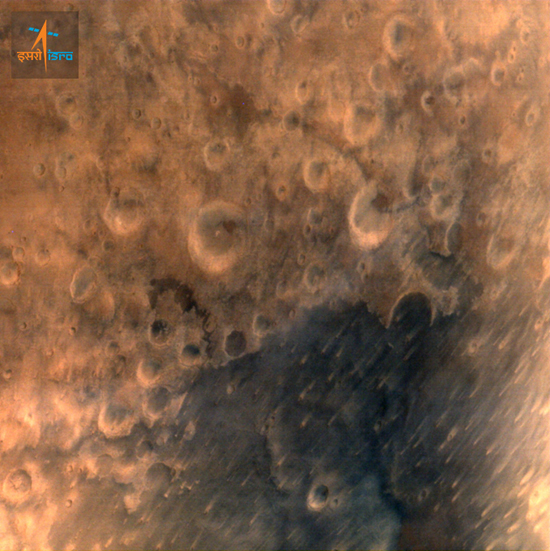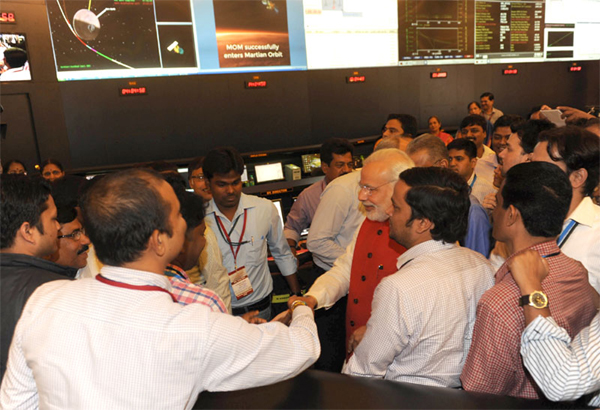| India
and US working together in Space, says Modi | New
York. Indian Prime Minister Narendra Modi has indicated that India and US are
cooperating in their Mars missions. Addressing a huge rally of Indian Americans
here Sep 28, he said that India and US were talking to each other not only here
(in US) but also there (around Mars). Notably, the first report of ISRO's
MOM entering the Mars orbit came from NASA's Deep Space Network (DSN) radar at
Canberra in Australia. Both US and India have similar DSN facilities but the US
network is global, and the biggest in the world. Mr Modi also said that
ISRO spent just around Rs 7 per km (or approx. US $ 1.1 per 10 km) for Mangalyaan's
650 million km journey to the Mars, and that many small industrial units contributed
in developing its components towards this technological milestone. Later,
after his meeting with President Barack Obama in Washington Sep 30, he observed
that India and US had reached Mars around the same time, and that this happy achievement
should augur well in developing the potential of Indo-US friendship. |
|
The
first to congratulate ISRO Chairman Dr K Radhakrishnan and scientists was Prime
Minister Narendra Modi, who visited the Indian Space Research Organisation (ISRO)
headquarters in India’s aerospace city of Bangalore to witness the momentous
occasion and share the joy with the scientists as soon as the MOM was injected
into the orbit at 7.54 am (IST) after a 24-minute firing of the onboard 440 Newton
Liquid Apogee Motor (LAM). “The success will go down as a landmark in history,”
he observed. Also to congratulate on ISRO’s tryst with Beyond the Blue
were President Pranab Mukherjee, Vice President Hamid Ansari and thousands of
citizens including children wanting to be astronauts. The success in fact
was an inspiring occasion particularly for children, and boys and girls as young
as 10 to 12, beamed with joy and said they would want to be astronauts. Deep
Space Network (DSN) Radars That the MOM, also called Mangalyaan (literally
moon craft in Hindi) was successfully swung into the red planet’s orbit was
also confirmed from US NASA’s DSN centres around the world, including at
Goldstone, Madrid (Spain) and Canberra (Australia). NASA, whose MAVEN spacecraft
is in the Martian orbit since September 21, flashed congratulations on its website
to compliment ISRO and India. The first report of Mangalyaan entering
the Mars orbit, in fact, came from Canberra. Soon after, the spacecraft arrived
in ISRO’s range, and the jubilation was magnified. ISRO’s own
DSN radar, with huge antennas, located at Bayalu near Bangalore, was receiving
signals from MOM. Later during the day, it stared receiving high resolution colour
pictures in accordance with the commands already loaded in MOM’s onboard
computers. ISRO’s DSN is similar in capability with NASA’s global
facilities to monitor deep space traffic. Indian scientists indicated that
ISRO and NASA have always been cooperating and that a data exchange between the
two institutions about their Martian spacecraft was likely. Right now, US and
India are only two countries in the world to have Mars missions and their MAVEN
and Mangalyaan comfortable neighbours to each other.  MOM’s
Instruments MOM’s
Instruments
The 475-kg Mangalyaan is carrying five scientific instruments
weighing 15 kg to study the Mars’ surface for water, methane and its mineral
and chemical composition. The presence of methane, if confirmed, will be the first
sign to indicate that life exists on the red planet in some form. Besides
the colour camera for optical imaging, other instruments on board include a Thermal
Infrared Imaging Spectrometer to map surface composition and mineralogy, Methane
sensor to detect presence of this gas, Mars Enospheric Neutral Composition Analyser
to study neutral composition of Mars’ upper atmosphere, and Lyman Alpha Photometer
for Deuterium and Hydrogen analysis. ISRO has already achieved success in
launching an unmanned moon mission, Chandrayaan (or moon craft) in 2008.
This was the first to locate water on the surface of moon with sophisticated sensors
built by US defence company Raytheon but contributed by a US research institution. Water
on Mars? NASA says that there should have been water on Mars. “Mars
was once awash with water. With the arrival of NASA's MAVEN mission at the red
planet, we may finally be close to working out where it all went.” Perhaps
Mangalyaan and MAVEN will find success in locating water, and perhaps together. ISRO’s
PSLV and GSLV Rockets ISRO Chairman K Radhakrishnan said India had proved
“our technological capabilities in outer space missions with an indigenous
rocket and our own spacecraft.” The Mars mission has proved to be a good
technology demonstrator. Set up in 1969, ISRO initiated space efforts with
very modest assistance from the US but then built a satellite, Aryabhatta, which
was launched by the Soviet Union on April 19, 1975. ISRO has sent numerous
satellites ever since, using its PSLV (Polar Satellite Launch Vehicles) and GSLV
(Geosynchronous Satellite Launch Vehicle) rockets for placing payloads in polar
and geostationary orbits respectively. It has eight onboard thrusters which use
liquid fuel as well as solar energy. Compared to 365 days of earth to orbit
the sun, Mars takes 687 days, and like the earth, it also has days and nights.
The Mars day however is for 24 hours and 37 minutes, or a bit longer than that
of the earth. MOM’s solar panels can generate electricity only when they
get sun. MOM itself will take 3.2 earth days to revolve around the Mars.  India’s
Weakness in Cryogenic Rockets India’s
Weakness in Cryogenic Rockets
ISRO’s only weakness yet in propulsion
technology has been in cryogenic rockets but authoritative sources told India
Strategic that success could be a few months away. “May be one
or two more launches, and then this would be confirmed.” Dr Radhakrishnan,
who was given a congratulatory hug by the Prime Minister, later said that ISRO
was planning to do a test flight of GSLV Mark-III with a passive cryogenic engine
– it will not be fired but just tested to validate its structural and aerodynamic
parameters – by December, or just about in two months. At present,
ISRO's PSLV launchers are used to propel satellites up to two tonnes. The GSLV
Mark-III will carry four tonnes, and once the technology is perfected, the new
launchers would be able to ferry up to 20 tonnes. At present, India routinely
launches its own small satellites and also some from other countries. It depends
on European Ariane for heavy satellites. In fact, HAL, which makes propulsion
systems for ISRO, announced that it is partnering with ISRO to make cryogenic
systems. HAL Chairman Dr RK Tyagi said, "An Integrated Cryogenic Engine manufacturing
Facility (ICMF) will be set up at HAL’s Aerospace Division here, and it will
manufacture cryogenic/ semi cryogenic engines for ISRO." Foreign
Collaboration in Cryogenic Technology Although France, Russia (earlier Soviet
Union) and US have cooperated with India in varying degrees on the space frontier,
none has shared the cryogenic technology. US aerospace company Boeing at one time
offered only “cryogenic tanks” but it was perhaps not accepted by India
as being too little. Notably, Russia did give half a dozen engines of older
technology but without the data on how to use them. “The experience in handling
them was useful nonetheless, and two private companies, Godrej and MTAR Technologies,
have contributed a lot in this direction. Software Also,
while India buys several off-the-shelf components from the open markets, the computer
programmes are developed indigenously for all Indian spacecraft. Indigenous software
is a key element in critical space ventures. MOM has been built indigenously
but several off-the-shelf commercially available components were acquired from
the global markets as per the standard global practice. There are plenty of critical
items like inertial guidance systems that are not made in India, due either to
lack of technology or commercial viability in making them at home. It makes sense
to buy them from wherever.  Cost Cost
Built
at a small cost of about $74 million (Rs 450 crore), MOM was launched on November
5, 2013 through a PSLV from India’s only spaceport at Sriharikota in the
Bay of Bengal, some 80 km from Chennai, the capital of India’s southern state
of Tamil Nadu. MOM travelled some 650 million km over nine months to reach the
designated orbit. It is moving around the Mars just 421.7 km at the closest
point and some 76,993.6 km at the farthest point in an elliptical orbit. Scientists
use gravity of the planets and the sun to sling manmade spacecraft into desired
orbits and that was done in this case also. Mangalyaan’s inclination
relative to Mars’ equator is 150 degrees. India’s
Place in Mars Missions India is the fourth country at present after US,
Russia and France (+Europe) with capability to launch missions of this scale.
India’s Space and Nuclear programmes are controlled directly by the
Prime Minister’s Office. In fact nearly all the Prime Ministers, notably
Mrs Indira Gandhi, Mr Rajiv Gandhi, Mr P V Narasimha Rao, Mr A B Vajpayee, Dr
Manmohan Singh and now Mr Modi have shown keen interest in steering them to success
and new frontiers. Globally, only 21 of the 51 Mars missions have succeeded
so far, and ISRO is the first organisation to achieve this technology milestone
in the first attempt. US was the first to touch the Mars orbit in 1963 with
the flyby Manner spacecraft to prove technology, Soviet Union the second in 1971
and the Ariane in 2003. Japan tried but failed in 1999. Dr Radhakrishnan
said that while India had proven its space technologies, ISRO would continue to
emphasise on strengthening launch, navigation, communication and endurance capabilities
of its systems, launchers and spacecraft. 
|